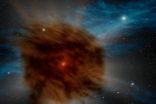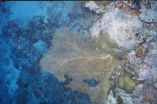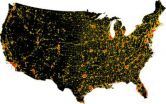(Press-News.org) COLUMBUS, Ohio -- A giant star in a faraway galaxy recently ended its life with a dust-shrouded whimper instead of the more typical bang.
Ohio State University researchers suspect that this odd event -- the first one of its kind ever viewed by astronomers – was more common early in the universe.
It also hints at what we would see if the brightest star system in our galaxy became a supernova.
In a paper published online in the Astrophysical Journal, Christopher Kochanek, a professor of astronomy at Ohio State, and his colleagues describe how the supernova appeared in late August 2007, as part of the Spitzer Space Telescope Deep Wide Field Survey.
The astronomers were searching the survey data for active galactic nuclei (AGN), super-massive black holes at the centers of galaxies. AGN radiate enormous amounts of heat as material is sucked into the black hole. In particular, the astronomers were searching for hot spots that varied in temperature, since these could provide evidence of changes in how the material was falling into the black hole.
Normally, astronomers wouldn't expect to find a supernova this way, explained then-Ohio State postdoctoral researcher Szymon Kozlowski. Supernovae release most of their energy as light, not heat.
But one very hot spot, which appeared in a galaxy some 3 trillion light years from Earth, didn't match the typical heat signal of an AGN. The visible spectrum of light emanating from the galaxy didn't show the presence of an AGN, either – the researchers confirmed that fact using the 10-meter Keck Telescope in Hawaii.
Enormous heat flared from the object for a little over six months, then faded away in early March 2008 – another clue that the object was a supernova.
"Over six months, it released more energy that our sun could produce in its entire lifetime," Kozlowski said.
The astronomers knew that if the source were a supernova, the extreme amount of energy it emitted would qualify it as a big one, or a "hypernova." The temperature of the object was around 1,000 Kelvin (about 700 degrees Celsius) -- only a little hotter than the surface of the planet Venus. They wondered -- what could absorb that much light energy and dissipate it as heat?
The answer: dust, and a lot of it.
Using what they learned from the Spitzer survey, the astronomers worked backward to determine what kind of star could have spawned the supernova, and how the dust was able to partly muffle the explosion. They calculated that the star was probably a giant, at least 50 times more massive than our sun. Such massive stars typically belch clouds of dust as they near the end of their existence.
This particular star must have had at least two such ejections, they determined – one about 300 years before the supernova, and one only about four years before it. The dust and gas from both ejections remained around the star, each in a slowly expanding shell. The inner shell – the one from four years ago – would be very close to the star, while the outer shell from 300 years ago would be much farther away.
"We think the outer shell must be nearly opaque, so it absorbed any light energy that made it through the inner shell and converted it to heat," said Kochanek, who is also the Ohio Eminent Scholar in Observational Cosmology.
That's why the supernova showed up on the Spitzer survey as a hot dust cloud.
Krzysztof Stanek, professor of astronomy at Ohio State, said that stars probably choked on their own dust much more often in the distant past.
"These events are much more likely to happen in a small, low metallicity galaxy," he said -- meaning a young galaxy that hadn't been around long enough for its stars to fuse hydrogen and helium into the more complex chemicals that astronomers refer to as "metals."
Still, Kozlowski added that more such supernovae will likely be found by NASA's Wide-field Infrared Explorer (WISE), which was launched in December 2009. "I would expect WISE to see 100 of these events in two years, now that we know what to look for," he said.
Because of the alignment of the galaxy with Earth and our sun, astronomers were not able to see what the event looked like to the naked eye while it was happening. But Kochanek believes that we might see the star brighten a decade or so from now. That's how long it will take for the shockwave from the exploding star to reach the inner dust shell and slam it into the outer shell. Then we'll have something to see here on Earth.
We do have at least one chance to see a similar light show closer to home, though.
"If Eta Carinae went supernova right now, this is what it would probably look like," Kochanek said, referring to the brightest star system in our Milky Way Galaxy.
The two stars that make up Eta Carinae are 7,500 light years away, and they host a distinctive dust shell dubbed the Homunculus Nebula, among other layers of dust. Astronomers believe that the nebula was created when the larger of the two stars underwent a massive eruption around 1840, and that future eruptions are likely.
INFORMATION:
NASA's Jet Propulsion Laboratory, Pasadena, Calif., manages the Spitzer Space Telescope mission for NASA's Science Mission Directorate, Washington. Science operations are conducted at the Spitzer Science Center at the California Institute of Technology, also in Pasadena. Caltech manages JPL for NASA.
This work was sponsored by NASA and the National Science Foundation. Kozlowski has since taken a new postdoctoral position at Warsaw University Observatory in Poland.
Contact: Christopher Kochanek, (614) 292-5954; Kochanek.1@osu.edu or Szymon Kozlowski, (614) 292-1773; simkoz@astronomy.ohio-state.edu or simkoz@astrouw.edu.pl
Giant star goes supernova -- and is smothered by its own dust
2010-10-13
ELSE PRESS RELEASES FROM THIS DATE:
Personal genetic profiling services lack evidence for claims
2010-10-13
Direct-to-consumer personal genetic profiling services that claim to predict people's health risks by analysing their DNA are often inconclusive and companies that sell them should provide better information about the evidence on which the results are based, says the UK Nuffield Council on Bioethics, in a new report on the ethics of so-called personalised healthcare services.
The report says that claims that these services are leading to a new era of 'personalised healthcare' are overstated and should be treated with caution. The Council recommends that regulators of ...
Coral records show ocean thermocline rise with global warming
2010-10-13
COLUMBUS, Ohio – Researchers looking at corals in the western tropical Pacific Ocean have found records linking a profound shift in the depth of the division between warm surface water and colder, deeper water traceable to recent global warming.
The finding is the first real evidence supporting what climate modelers have been predicting as the effects of global climate change on the subsurface ocean circulation.
The report by researchers from Ohio State University and the University of Toronto was published in the latest online edition of the journal Geophysical Research ...
sonRAIL -- computer model to calculate noise levels along the Swiss rail network
2010-10-13
Goods trains move at night because during daytime the Swiss rail system is used to full capacity by passenger traffic. Unfortunately, it is goods trains which make the most noise – and they operate at exactly the time when most people want to sleep. If the policy of shifting goods transport from the roads to the rail network is to succeed, then goods trains must be made significantly quieter.
The Swiss Federal Office for the Environment (FOEN) therefore tasked a team of scientists, headed by Kurt Eggenschwiler of Empa's Acoustics and Noise Control Laboratory, with the ...
Canadian leads publishing of first results from Large Hadron Collider
2010-10-13
Researchers used Einstein's famous E=mc2 equation and the Large Hadron Collider to recreate a miniature version of the event at the origins of our Universe, and the first findings from their work were published in the journal Physical Review Letters. Dr. Andreas Warburton of McGill's Department of Physics made leading contributions to the analysis of data from the experiment, known as "ATLAS," meaning the findings have a special significance for Canadian science.
Warburton and 3171 colleagues from around the world are using the data collected from the recreation in an ...
Population change: Another influence on climate change
2010-10-13
Changes in the human population, including aging and urbanization, could significantly affect global emissions of carbon dioxide over the next 40 years, according to research results published this week.
The research, results of which appear in a paper in the journal Proceedings of the National Academy of Sciences (PNAS), was conducted by scientists at the National Center for Atmospheric Research (NCAR), the International Institute for Applied Systems Analysis (IIASA) and the National Oceanographic and Atmospheric Administration (NOAA).
It was funded by the National ...
K-State advances field of ecological genomics with research, symposium
2010-10-13
MANHATTAN, KAN. -- A Kansas State University professor's research and the upcoming Ecological Genomics Symposium continue to make the university a leader in the emerging field of ecological genomics.
Ecological genomics is an integrated field that focuses on how organisms, ecosystems and communities respond to environmental change. It uses genomic technologies, such as gene sequencing and expression analysis, on a wider scale to ask and research ecological questions, said Michael Herman, associate professor of biology.
"We're working hard to advance this field," Herman ...
Pediatric hospitalizations for ATV-related injuries more than double
2010-10-13
All-Terrain Vehicles (ATVs) are associated with a significant and increasing number of hospitalizations for children in the U.S., according to a new report by the Center for Injury Research and Policy at the Johns Hopkins Bloomberg School of Public Health. Over a nine- year period (1997-2006) hospitalizations for ATV injuries increased 150 percent among youth younger than 18 years, with important demographic variations. Rates increased the most dramatically in the South and Midwest, and among teens ages 15 to 17. While males between 15 to 17 have the highest rate of ATV ...
U of M researchers find children's health insurance coverage varies widely
2010-10-13
MINNEAPOLIS/ST.PAUL (Oct. 12, 2010) – Children's health insurance coverage still varies significantly at both the state and national levels, according to researchers at the University of Minnesota School of Public Health (SPH). In particular, researchers found gaps in coverage that vary across states by age, race/ethnicity and income.
Even states with relatively low rates of uninsured children have gaps in coverage for some groups of children, according to researchers. Conversely, some states demonstrating high rates of uninsurance have relatively low gaps or disparity ...
1 step closer to a drug treatment for cystic fibrosis, MU professor says
2010-10-13
COLUMBIA, Mo. – A University of Missouri researcher believes his latest work moves scientists closer to a cure for cystic fibrosis, one of the world's most common fatal genetic diseases.
The Journal of Biological Chemistry has published findings by Tzyh-Chang Hwang, a professor in the School of Medicine's Department of Medical Pharmacology and Physiology and the Dalton Cardiovascular Research Center. The publication has been recognized as the "paper of the week" for the journal, meaning Hwang's work is considered to be in the top 1 percent of papers reviewed annually ...
Gambling on bacteria
2010-10-13
When it comes to gambling, many people rely on game theory, a branch of applied mathematics that attempts to measure the choices of others to inform their own decisions. It's used in economics, politics, medicine -- and, of course, Las Vegas. But recent findings from a Tel Aviv University researcher suggest that we may put ourselves on the winning side if we look to bacteria instead.
According to Prof. Eshel Ben-Jacob of Tel Aviv University's School of Physics and Astronomy, current game theory can't account for bacteria's natural decision-making abilities -- it's just ...


